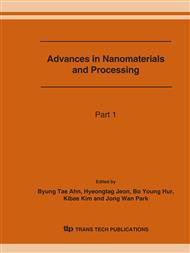p.715
p.719
p.723
p.727
p.731
p.735
p.739
p.743
p.747
Sintering and Oxygen Ionic Conducting Properties of Bi2V0.9Co0.1O5.5-δ Derived from an EDTA-Citrate Precursor
Abstract:
Bi2V0.9Co0.1O5.5-δ with a pure Aurivillius phase was synthesized by a sol-gel method using EDTA and citric as mixed complexing agents. It was found that homogeneous and fine powder (100-200 nm) with a pure Aurivillius phase can be produced by calcining the complex precursor at 450 °C for 1h in air. The sintering properties of Bi2V0.9Co0.1O5.5-δ were investigated in the range of 560-680 °C with respect to relativity density. Sintering at 640 °C was ascertained to be preferred for Bi2V0.9Co0.1O5.5-δ, producing a dense microstructure with uniform grains around 3-5 μm. The Bi2V0.9Co0.1O5.5-δ ceramic exhibits an oxygen ionic conductivity of 1.0×10-1 S·cm-1 at 600 °C. The difference between the activation energies for the ionic conducting in low and high temperature regions is qualitatively interpreted in terms of an order-disorder phase transition. This research demonstrates the advantage of the EDTA-citrate method in preparing Bi2V0.9Co0.1O5.5-δ with respect to the simplicity of synthesis process, desired morphology of synthesized powder, low sintering temperature and superior ionic conducting properties of ceramic specimen.
Info:
Periodical:
Pages:
731-734
Citation:
Online since:
June 2007
Authors:
Price:
Сopyright:
© 2007 Trans Tech Publications Ltd. All Rights Reserved
Share:
Citation:


